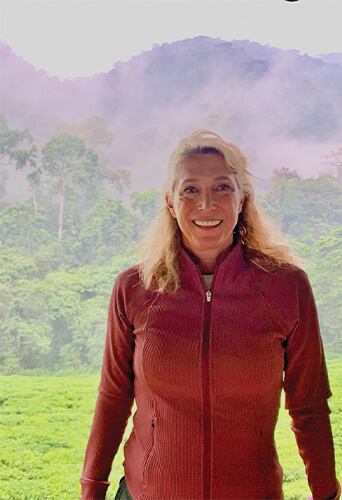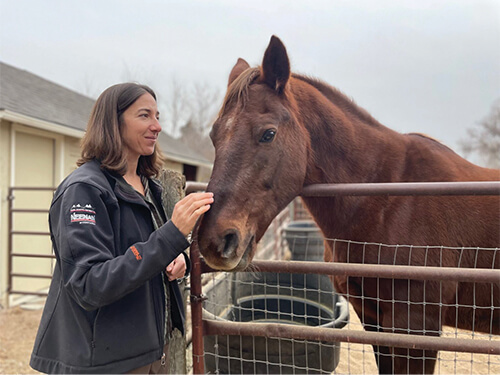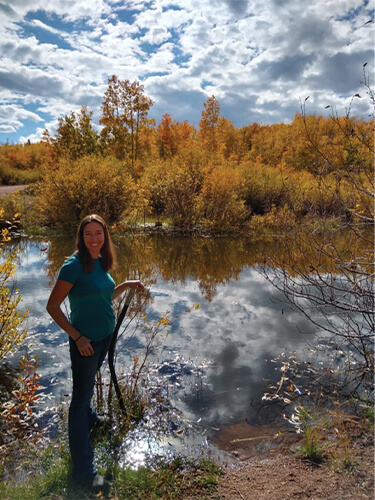While COVID-19 has been racing through much of the human population, the SARS-CoV-2 virus has also turned up in other mammals. This leads to many questions: Might these animals serve as reservoirs where new variants can emerge and then infect humans? Can animal surveillance identify novel variants before they appear in humans? How dangerous is COVID-19 to nonhuman animals?
“There’s evidence of transmission in deer, in small mammals that are raised for fur in the U.S. and in other countries, and in rodents, so really any mammal is suspect right now. We need to know which variants transmit between animals in a wild-reservoir setting, and what that means for adaptation of the virus and future risk for re-emergence into the human population,” said researcher Christine Johnson, VMD, Ph.D., professor of epidemiology and ecosystem health, and director of the EpiCenter for Disease Dynamics at the One Health Institute, University of California at Davis (UC Davis), Davis, CA, USA (Figure 1). She also leads the multi-institution EpiCenter for Emerging Infectious Disease Intelligence at UC Davis.

Figure 1. UC Davis epidemiologist Christine Johnson, VMD, Ph.D., paused from fieldwork in Bwindi Impenetrable Forest in Uganda, where she collaborates with local scientists, including public health and wildlife health specialists to study emerging infectious disease. The team is investigating acute febrile illness in people and sampling bats and nonhuman primate hosts to understand zoonotic virus transmission in this region, notably how viruses are adapting at animal–human interfaces along the forest edge. (Photo courtesy of UC Davis.)
“I think for the current pandemic with SARS-CoV-2, it is absolutely fundamental to start to take some of the innovation that’s been happening (on the human side) and bring it into that animal health realm, so that we can track the course of this pandemic in animals, and get a better picture of what is poised to happen next,” Johnson asserted.
Viral back-and-forth
Multiple studies and reports back Johnson’s assessment of the extent of infection in nonhuman mammals, such as:
- Surveys showing high percentages of sampled white-tailed deer (e.g., 67% in Michigan, 33% in Iowa) with either presence of the SARS-CoV-2 virus or antibodies to it [1], [2], with one study noting the findings had “important implications for the long-term persistence of the SARS-CoV-2 pandemic.”
- Reports of infection among farmed mink in numerous countries, as well as identification of potentially dangerous variants and mink-to-human transmission [3], [4].
- Recent culling of hamsters in Hong Kong after a human COVID-19 outbreak was linked to rodents in a pet store [5].
- Colorado State University (CSU) studies [6]–[8] identifying pet cats, and wild animals such as deer mice, bushy-tailed woodrats, and striped skunks, as susceptible to infection, and therefore providing “evidence that human–wildlife interactions could result in continued transmission of SARS-CoV-2.” In addition, the house-cat study noted that the animals recovered quickly from the infection, but also resisted reinfection, suggesting they could be model organisms for developing human vaccines.
Studies like these raised concerns that the virus could spread within infected animal populations, potentially accumulate mutations that might enhance transmissibility and/or virulence, and then jump back to people as dangerous, possibly vaccine-evading variants.
As of January 2022, only farmed mink and pet-store hamsters had been identified as transmitting SARS-CoV-2 to people, but that does not necessarily mean they are the only species capable of doing so, according to Johnson. That’s because animal-to-human transmissions are a drop in the bucket compared to the massive number of human-to-human transmissions occurring in many countries, she said. “Hong Kong didn’t have ongoing human-to-human transmission, so when they had a cluster of COVID-19 cases, it was so unusual that they were able to track it back to one pet store and then to hamsters. But it would be very hard to know about such animal-to-human transmission in the United States or other countries where there is major ongoing transmission between people.”

Figure 2. CSU veterinarian and infectious disease researcher Angela Bosco-Lauth, Ph.D., DVM, has been testing for susceptibility to SARS-CoV-2 in a variety of peridomestic animals, ranging from pets to livestock [9] and human-associated wild animals, and has found that several species are vulnerable to infection. (Photo courtesy of CSU.)

Figure 3. One of Bosco-Lauth’s concerns falls on the animal side, and whether the virus might pose a serious threat to as-yet-untested animals, including threatened species, which could in turn lead to ecosystem-level consequences. (Photo courtesy of CSU.)
Remarked Johnson, “We’ve all been so focused on the human dimension, and rightly so, but we need to understand the animal health component, too, and we’re at the very forefront of hoping to pivot some of the effort and energy toward looking into potential wild-animal reservoirs so we can inform the future trajectory of the SARS-CoV-2 pandemic.”
Researchers wanted
Besides providing insight into the current pandemic, a better understanding of transmission within animal species, and of interspecies transmissions (collectively called spillover) can aid preparations for the next human pandemic, Johnson said, and this is where biomedical researchers can put their skills to work.
“We need to harness the creativity and ingenuity that engineers and computer scientists bring on the biomedical and data sides, and use it to look for emerging infectious disease at the point of spillover before they cause a pandemic,” she remarked. For example, she noted that coronaviruses are not only some of the most common and prevalent viruses in nature, but they also are capable of recombination, which presents the opportunity to create novel threats.
With ongoing spillover, as well as the advent of new pathogens, she added, examination of the animal–human interface might reveal important information about emergence factors and viral characteristics that could then inform development of diagnostic, treatment, or vaccine technologies.
Bosco-Lauth hopes today’s intense emphasis on SARS-CoV-2 research will lead to an increase in wildlife surveillance, including development of banks of serum or other samples that could serve as a look back in time to track the origins of emerging pathogens. “Having that information available, or at least having access to those samples, is really important,” she remarked.
Interdisciplinary contributions are vital to such efforts, including a new open-source web tool that ranks pathogens based on their risk of spillover, noted Johnson, who is part of the team that developed the tool under the United States Agency for International Development (USAID) PREDICT Project [8].
Collaborations between researchers in different fields is not always easy, but Johnson insists they are well worth the effort. “I am having to learn what engineers need from the cooperation, what makes it work for them, what part of the way that I talk is not easily understood based on their discipline and their expertise, and how I can adapt so that we’re really conversing at a high level right from the get-go … and vice versa, so we need to figure out some things,” she said. “Then again, I’ve not been in the company of engineers and computer scientists like current times, and we’re seeing a tidal wave of innovation that I hope we can ride into the future for what needs to happen in this space. It’s really been remarkable.”
References
- U.S. Department of Agriculture’s Animal and Plant Health Inspection Service, “Questions and answers: Results of study on SARS-CoV-2 in white-tailed deer,” bulletin APHIS 11-55-014, Aug. 2021. Accessed: Feb. 21, 2022. [Online]. Available: https://www.aphis.usda.gov/animal_health/one_health/downloads/qa-covid-white-tailed-deer-study.pdf.
- S. V. Kuchipudi et al., “Multiple spillovers from humans and onward transmission of SARS-CoV-2 in white-tailed deer,” PNAS, vol. 119, no. 6, p. e2121644119, Feb. 2022. Accessed: Feb. 21, 2022. [Online]. Available: https://pubmed.ncbi.nlm.nih.gov/35078920/
- K. Sharun, R. Tiwari, S. Natesan, and K. Dhama, “SARS-CoV-2 infection in farmed minks, associated zoonotic concerns, and importance of the one health approach during the ongoing COVID-19 pandemic,” Vet. Quart., vol. 41, no. 1, pp. 50–60, Jan. 2021.
- C. A. Devaux, L. Pinault, J. Delerce, D. Raoult, A. Levasseur, and R. Frutos, “Spread of mink SARS-CoV-2 variants in humans: A model of sarbecovirus interspecies evolution,” Frontiers Microbiol., vol. 12,
p. 675528. Sep. 2021. Accessed: Feb. 21, 2022. [Online]. Available: https://doi.org/10.3389/fmicb.2021.675528 - J. Pang and T. Siu, “Hong Kong to cull 2,000 hamsters after COVID-19 outbreak,” Reuters, Jan. 18, 2022. Accessed: Feb. 21, 2021. [Online]. Available: https://www.reuters.com/world/china/hong-kong-orders-hamster-cull-after-covid-19-hits-pets-2022-01-18/
- A. M. Bosco-Lauth et al., “Experimental infection of domestic dogs and cats with SARS-CoV-2: Pathogenesis, transmission, and response to reexposure in cats,” PNAS, vol. 117, no. 42, pp. 26382–26388, Oct. 2020.
- A. M. Bosco-Lauth et al., “Peridomestic mammal susceptibility to severe acute respiratory syndrome coronavirus 2 infection,” Emerg. Infectious Diseases, vol. 27, no. 8, pp. 2073–2080, Aug. 2021.
- Z. L. Grange et al., “Ranking the risk of animal-to-human spillover for newly discovered viruses,” PNAS, vol. 118, no. 15, p. e2002324118, Apr. 2021. Accessed: Feb. 21, 2022. [Online]. Available: https://www.pnas.org/content/118/15/e2002324118 [9] A. M. Bosco-Lauth et al., “Susceptibility of livestock to SARS-CoV-2 infection,” Emerg. Microbes Infections, vol. 10, no. 1, pp. 2199–2201, Dec. 2021.



